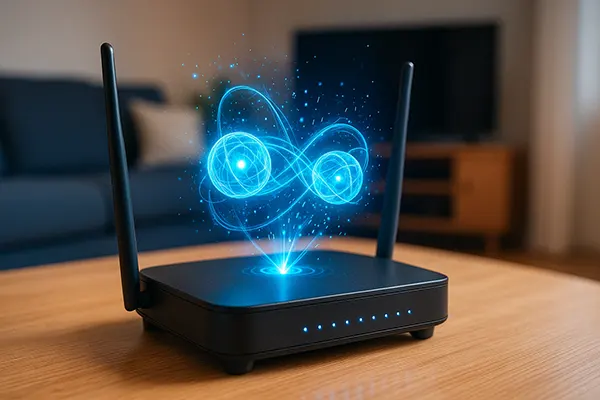
Quantum Wi-Fi: Real-World Testing and Its Potential for Home Networks in 2025
Quantum technologies have steadily moved from the realm of theoretical physics to practical applications, with quantum computing and quantum communication leading the charge. One of the most compelling areas of development in 2025 is Quantum Wi-Fi, which promises ultra-secure, ultra-fast wireless connectivity powered by the principles of quantum mechanics. As the first real-world tests emerge, industry experts and consumers alike are evaluating whether this revolutionary technology is ready to transform the way we connect at home.
The Emergence of Quantum Wi-Fi in Real-World Conditions
Until recently, quantum networking existed only in research labs and government experiments. In February 2025, several major players in the tech industry, including China’s Tsinghua University and Europe’s Quantum Internet Alliance, completed the first successful trials of quantum Wi-Fi protocols over short-range home and office networks. These trials focused on applying Quantum Key Distribution (QKD) and entanglement-based authentication to real-world routers and devices.
The results were promising. Unlike traditional Wi-Fi that transmits data through radio frequencies susceptible to interception, quantum Wi-Fi uses quantum bits (qubits) that collapse if tampered with, making eavesdropping nearly impossible. This makes it a compelling solution for households concerned with cybersecurity.
Furthermore, the tests demonstrated stable connectivity across a range of 10–20 metres, suitable for most residential environments. While still in early development, the trials showed that quantum routers could potentially operate alongside existing fibre-optic infrastructure with minor upgrades, suggesting that mass adoption could be feasible in the near future.
Integration with Existing Home Infrastructure
One of the central challenges of bringing quantum Wi-Fi into homes is ensuring compatibility with current consumer technology. In 2025, researchers have started integrating quantum modules into standard routers, enabling hybrid systems that switch between traditional and quantum data modes based on the level of security required. This method significantly reduces the cost barrier for early adopters.
Companies like Toshiba and Huawei have already introduced prototype routers capable of supporting quantum cryptography alongside 6 GHz Wi-Fi 6E frequencies. These routers can negotiate secure quantum keys and simultaneously provide high-speed wireless data, improving both safety and performance without demanding users overhaul their setups.
This strategy opens a path to gradual deployment. Users can enjoy familiar interfaces and devices while benefitting from an unprecedented layer of digital protection. It also positions quantum Wi-Fi not as a replacement but as an enhancement, making it more appealing to consumers and ISPs alike.
Benefits and Limitations of Quantum Wi-Fi for Consumers
Quantum Wi-Fi’s standout feature is security. With cyberattacks becoming more sophisticated, having an inherently tamper-proof communication protocol adds a strong layer of defence. In real-world tests, QKD prevented common threats such as man-in-the-middle attacks, device spoofing, and signal injection, giving it a critical edge over current encryption methods.
Another advantage lies in bandwidth potential. Quantum protocols reduce signal interference and promise more efficient data transmission. This is particularly relevant for smart homes with multiple connected devices requiring secure, uninterrupted connectivity.
However, limitations remain. Quantum routers currently demand precise calibration and controlled environmental conditions to maintain qubit coherence. They are sensitive to temperature, vibrations, and electromagnetic noise. This restricts deployment in rural areas or homes with older wiring, and could slow down mass-market penetration unless robust commercial hardware is developed.
Costs and Market Accessibility in 2025
As of early 2025, the cost of quantum Wi-Fi equipment remains high. Entry-level routers with basic QKD support start at approximately £2,000, while advanced models developed for enterprise-level security can exceed £10,000. Although this is a significant barrier, industry trends suggest rapid cost reductions through mass production and competition among tech firms.
Several governments are subsidising quantum networking R&D. The EU’s Quantum Flagship Programme and the US National Quantum Initiative have both earmarked funding to develop consumer-grade quantum technologies. This financial support is expected to drive innovation and lower prices over the next 18–24 months.
Retailers are also beginning to show interest. Tech giants like Amazon and Best Buy have signed agreements to begin stocking quantum routers for home use in late 2025. If early adopters report positive outcomes, a trickle-down effect could occur, leading to wider distribution and more affordable options.

Future Potential of Quantum Wi-Fi in Home Networks
The long-term potential of quantum Wi-Fi goes beyond secure browsing. Experts believe it could become the backbone of next-generation digital homes, integrating seamlessly with quantum cloud computing, decentralised applications, and secure video conferencing. This could transform remote work, online education, and telemedicine by safeguarding sensitive data in transit.
Quantum networking also has potential implications for Internet of Things (IoT) ecosystems. Devices such as smart thermostats, cameras, and appliances could soon communicate using encrypted quantum channels, eliminating many vulnerabilities present in traditional systems. This would mark a massive leap forward in both safety and performance.
By 2030, quantum Wi-Fi may become as ubiquitous as fibre broadband is today. However, this vision hinges on advances in miniaturisation, cost-efficiency, and public policy support. With 2025’s successful trials marking a pivotal step forward, the path toward everyday use of quantum networking is now clearer than ever.
Policy and Industry Trends Driving Adoption
Government regulations are beginning to reflect the need for quantum-safe communication. The European Union is drafting standards that mandate post-quantum encryption for critical infrastructure and high-risk communications. Such policies are expected to trickle into residential technologies in the coming years.
Meanwhile, private-sector initiatives are accelerating. Tech firms are partnering with universities and telecoms to develop regional testbeds for quantum Wi-Fi deployment. For instance, a UK-based pilot programme is currently underway in Cambridge, aiming to test quantum routers in council housing and assess scalability and user experience.
The push from both regulators and innovators suggests that quantum Wi-Fi will not remain a niche technology. As awareness grows and technological hurdles are addressed, adoption is expected to expand rapidly, reshaping home connectivity in ways previously thought impossible.
